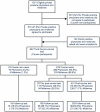An interactive internet-based continuing education course on sexually transmitted diseases for physicians and midwives in Peru
- PMID: 21573054
- PMCID: PMC3090386
- DOI: 10.1371/journal.pone.0019318
An interactive internet-based continuing education course on sexually transmitted diseases for physicians and midwives in Peru
Abstract
Background: Clinicians in developing countries have had limited access to continuing education (CE) outside major cities, and CE strategies have had limited impact on sustainable change in performance. New educational tools could improve CE accessibility and effectiveness.
Methodology/principal findings: The objective of this study was to evaluate an interactive Internet-based CE course on Sexually Transmitted Diseases (STDs) management for clinicians in Peru. Participants included physicians and midwives in private practice drawn from a census of 10 Peruvian cities. The CE included a three-hour workshop for improving Internet skills, followed by a 22-hour online course on STD-syndrome-management, with subsequent educational support. The course used case-based clinical vignettes tailored to local STD problems. Knowledge and reported practices on STD management were assessed before, immediately after and at four months after completion of the course. Statistical analysis included parametric tests-linear regression multivariate analysis, paired t-test and repeated measures ANOVA using SPSS 14.0. Of 1,071 eligible clinicians, 510 agreed to participate, as did an additional 132 public sector clinicians. Of these 642 participants, 619 (96.4%) completed the course, and 596 (96.3%) took the four-month follow-up evaluation. Physician and midwife scores improved from 64.2% correct answers on the pre-test to 77.9% correct on the four-month follow-up test (p<0.001). Most participants (95%) found the online course useful for their work needs. Self reported STD management practices did not change.
Conclusions/significance: Among physicians and midwives in Peru, an Internet-based CE course was feasible, acceptable with high participation rates, and led to sustained improvement in knowledge at four months. Further studies are needed to test it as a model for improving the training of physicians, midwives, and other health care providers.
Conflict of interest statement
Figures
Similar articles
-
Improved STD syndrome management by a network of clinicians and pharmacy workers in Peru: The PREVEN Network.PLoS One. 2012;7(10):e47750. doi: 10.1371/journal.pone.0047750. Epub 2012 Oct 17. PLoS One. 2012. PMID: 23082208 Free PMC article.
-
Improving sexually transmitted disease management in the private sector: the Jamaica experience.AIDS. 1998;12 Suppl 2:S67-72. AIDS. 1998. PMID: 9792363
-
Can experiential-didactic training improve clinical STD practices?Sex Transm Dis. 2011 Jun;38(6):516-21. doi: 10.1097/OLQ.0b013e3182045306. Sex Transm Dis. 2011. PMID: 21233790
-
Designing tailored Web-based instruction to improve practicing physicians' chlamydial screening rates.Acad Med. 2002 Sep;77(9):929. doi: 10.1097/00001888-200209000-00032. Acad Med. 2002. PMID: 12228099 Review.
-
Problems and proposals for the surveillance and control of sexually transmitted diseases associated with pelvic inflammatory disease in South America.Am J Obstet Gynecol. 1980 Dec 1;138(7 Pt 2):1078-81. doi: 10.1016/0002-9378(80)91111-4. Am J Obstet Gynecol. 1980. PMID: 7008598 Review.
Cited by
-
A novel educational strategy targeting health care workers in underserved communities in Central America to integrate HIV into primary medical care.PLoS One. 2012;7(10):e46426. doi: 10.1371/journal.pone.0046426. Epub 2012 Oct 24. PLoS One. 2012. PMID: 23115628 Free PMC article.
-
Improved knowledge and reported practice regarding sexually transmitted infections among healthcare providers in rural Vietnam: a cluster randomised controlled educational intervention.BMC Infect Dis. 2014 Dec 4;14:646. doi: 10.1186/s12879-014-0646-5. BMC Infect Dis. 2014. PMID: 25471366 Free PMC article. Clinical Trial.
-
Prevention of sexually transmitted infections in urban communities (Peru PREVEN): a multicomponent community-randomised controlled trial.Lancet. 2012 Mar 24;379(9821):1120-8. doi: 10.1016/S0140-6736(11)61846-1. Epub 2012 Feb 15. Lancet. 2012. PMID: 22341824 Free PMC article. Clinical Trial.
-
On the advantages and disadvantages of virtual continuing medical education: a scoping review.Can Med Educ J. 2023 Jun 27;14(3):41-74. doi: 10.36834/cmej.75681. eCollection 2023 Jun. Can Med Educ J. 2023. PMID: 37465741 Free PMC article.
-
Improved STD syndrome management by a network of clinicians and pharmacy workers in Peru: The PREVEN Network.PLoS One. 2012;7(10):e47750. doi: 10.1371/journal.pone.0047750. Epub 2012 Oct 17. PLoS One. 2012. PMID: 23082208 Free PMC article.
References
-
- Davis DA, Thomson MA, Oxman AD, Haynes RB. Evidence for the effectiveness of CME. A review of 50 randomized controlled trials. JAMA. 1992;268:1111–1117. - PubMed
-
- Cook DA, Gelula MH, Lee MC, Bauer BA, Dupras DM, et al. A web-based course on complementary medicine for medical students and residents improves knowledge and changes attitudes. Teach Learn Med. 2007;19:230–238. - PubMed
-
- Harden RM. A new vision for distance learning and continuing medical education. J Contin Educ Health Prof. 2005;25:43–51. - PubMed
Publication types
MeSH terms
Grants and funding
LinkOut - more resources
Full Text Sources
Medical
Research Materials



